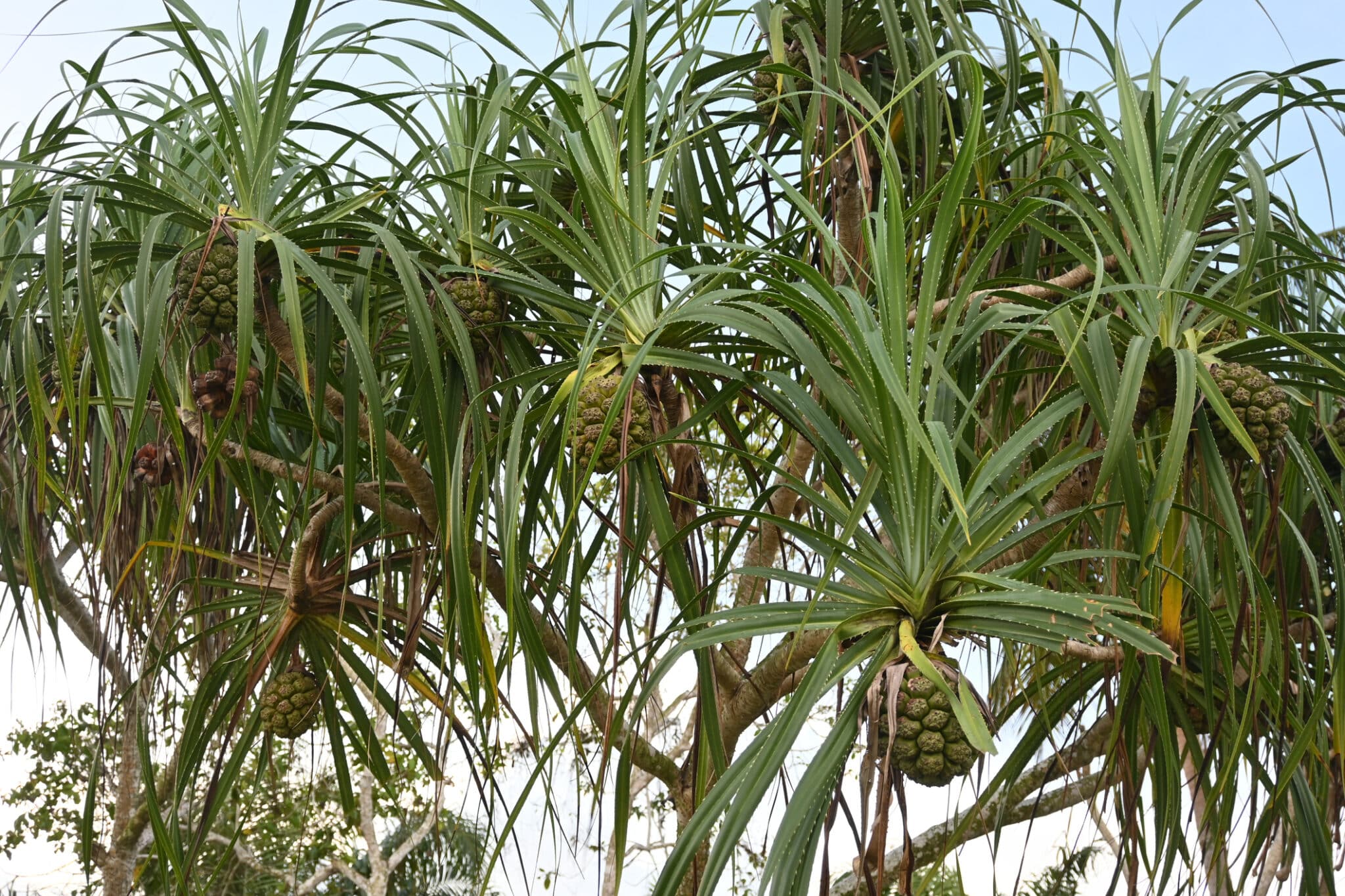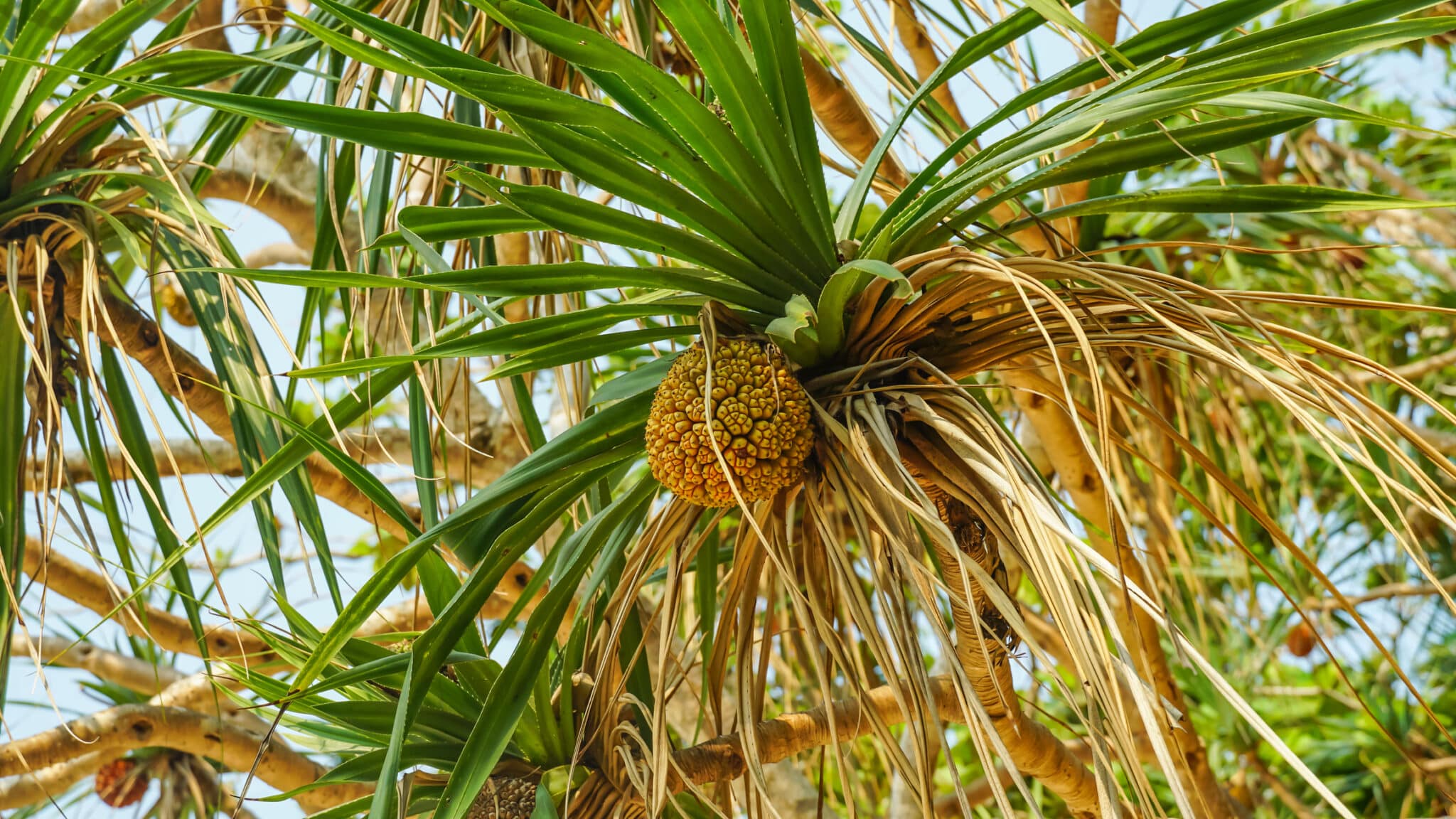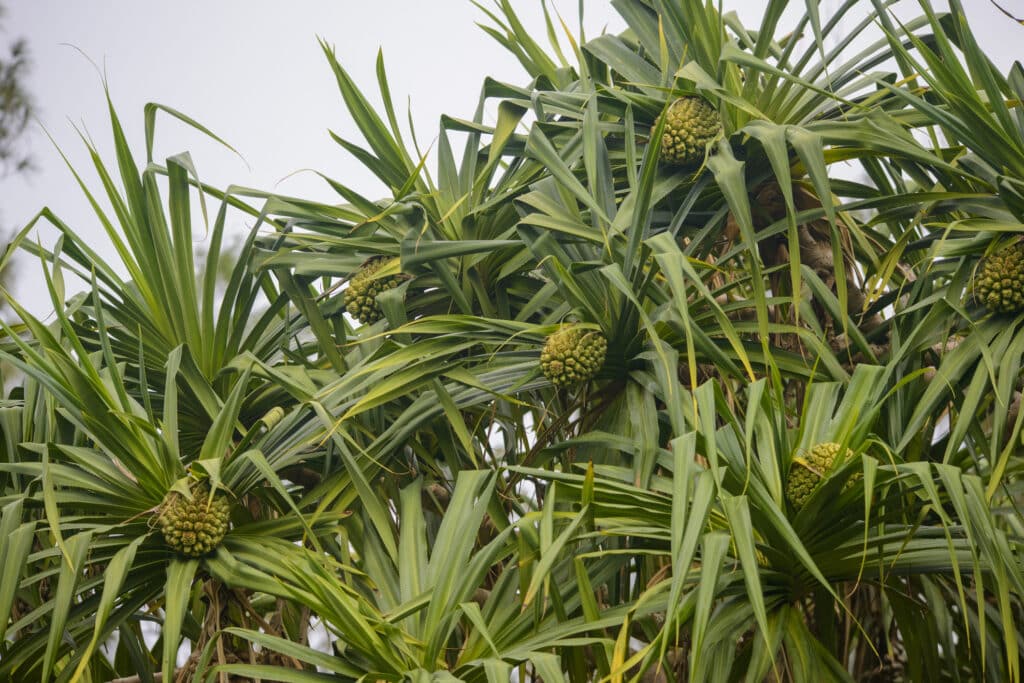Did you know that the Pandanus tectorius, commonly known as Pandanus or Hala, is more than just a plant—it’s a cornerstone of Hawaiian culture and ecology? This remarkable species, with its striking appearance and cultural versatility, is treasured for its contributions to traditional crafts, sustainable living, and coastal ecosystems.
Pandanus is renowned in Hawaii for its woven leaves, used in creating mats, baskets, and hats, as well as its strong fibers for cordage. Beyond its cultural significance, it plays a vital ecological role, thriving in coastal areas where it helps prevent erosion and provides shelter to local wildlife.
Pandanus Details
The Pandanus tectorius is a striking plant that stands out due to its distinctive physical traits and adaptability. It typically grows as a small to medium-sized tree, reaching heights of 20 to 30 feet, with a slender trunk supported by its iconic aerial roots.
These aerial roots not only provide stability in coastal areas but also enhance the plant’s ability to absorb nutrients from the surrounding soil. Its long, narrow leaves, which can grow up to 5 feet in length, are arranged in a unique spiral pattern and feature serrated edges, making them both functional and visually appealing.
Varieties and Cultivars
The Pandanus tectorius includes several species and regional cultivars, each showcasing unique adaptations and features. These varieties are not only ecologically significant but also hold immense cultural and practical value in Hawaii and other tropical regions. Below are some notable varieties and cultivars of Pandanus:
- Pandanus utilis: Commonly known as the “Common Screw Pine,” this variety is characterized by its larger leaves, which are highly valued for weaving mats, baskets, and other traditional crafts. It is widely cultivated in tropical regions and is known for its robust growth and ornamental appeal.
- Pandanus odorifer: This species is notable for its fragrant fruits and striking appearance, making it a popular choice for ornamental planting. Its ability to thrive in coastal areas with sandy soils makes it ideal for landscaping in Hawaiian coastal gardens.
- Pandanus spiralis: Also known as the “Spiral Pandan,” this variety is native to Australia but is also found in Hawaii. It is recognized for its distinctively spiraled leaf arrangement and is often used for decorative purposes in gardens.
- Pandanus tectorius ‘Hala’: The native Hawaiian variety, Hala, is particularly suited for coastal environments. It has strong aerial roots, vibrant orange-red fruits, and long, durable leaves used extensively in traditional Hawaiian weaving.
Each of these varieties is uniquely suited to specific environments and purposes. In Hawaii, the adaptability of the hala tree and its cultural integration highlight its significance.
These varieties also play a role in ecological restoration, creating windbreaks, preventing coastal erosion, and supporting biodiversity.

Best Time to Plant
Year-Round Planting Feasibility
The Pandanus tectorius is a highly adaptable plant that can be planted year-round in tropical climates, particularly in Hawaii. Thanks to its resilience, it thrives in various conditions, making it an excellent option for home gardens and coastal landscapes regardless of the season.
Its ability to establish itself in sandy, well-drained soils and its tolerance to fluctuating weather conditions allow for flexibility in planting schedules. Whether planted in summer or winter, the Pandanus shows steady growth when provided with adequate care and proper growing conditions.
Ideal Planting Seasons in Hawaii
While Pandanus can be planted at any time of the year, the best seasons for planting in Hawaii are typically spring and early summer. During these months, the warmer temperatures and increased rainfall create ideal conditions for root establishment and overall plant growth.
Spring planting ensures that the plant has ample time to grow strong before facing the drier months, reducing the need for supplemental watering. Early summer planting is also advantageous due to consistent sunlight, which supports faster leaf and aerial root development.
Growing Conditions
Ideal Soil Types and pH Levels
The Pandanus tectorius thrives in a wide variety of soil types but performs best in sandy, well-drained soils. These conditions mimic its natural habitat in coastal regions, allowing the plant to establish its roots effectively.
While it is highly adaptable, soils with a slightly acidic to neutral pH range of 6.0 to 7.5 are ideal for optimal growth. The plant’s tolerance for poor and saline soils makes it particularly suitable for areas where other plants might struggle, such as coastal gardens or sandy uplands.
To encourage healthy growth, incorporating organic matter into the soil can improve its structure and nutrient retention, creating an even better-growing environment.
Light Requirements
Pandanus thrives in full sunlight but can tolerate partial shade, making it a versatile plant for various landscapes. For maximum growth and fruit production, it is recommended to plant Pandanus in areas that receive at least 6 to 8 hours of direct sunlight daily.
However, young plants may benefit from some light shading to protect their tender leaves from scorching during the hottest part of the day.
Its ability to adapt to different light conditions makes it an excellent choice for open spaces, coastal regions, or partially shaded gardens. Ensuring proper sunlight exposure is crucial for the plant’s vibrant appearance and healthy development.
Temperature and Humidity Preferences
As a tropical plant, Pandanus thrives in warm climates with high humidity levels. It is ideally suited for temperatures between 70°F and 90°F, common in Hawaii’s coastal and lowland regions.
The plant exhibits excellent heat tolerance, but prolonged exposure to cold temperatures below 50°F can stunt its growth or cause damage.
High humidity further supports its growth by maintaining moisture levels around its foliage and aerial roots. When grown in drier areas, supplemental watering, and mulching can help mimic its preferred humid conditions, ensuring consistent growth.
Salt and Wind Tolerance
One of the Pandanus tectorius’s most remarkable features is its exceptional tolerance to salt and wind, making it a natural choice for coastal landscapes. It can withstand salty sea spray and sandy soils, thriving in areas where other plants may struggle.
The plant’s aerial roots provide additional stability in windy conditions, allowing it to anchor firmly even in exposed environments.
These qualities not only make Pandanus a resilient option for challenging locations but also highlight its value as a natural windbreak and erosion control plant in coastal regions.
Planting Instructions
Step-by-Step Guide
Planting Pandanus tectorius requires attention to site preparation and proper planting techniques to ensure its long-term success. Follow these steps for the best results:
- Choose the Right Location: Select a well-draining area with full sun or partial shade to provide the optimal environment for growth.
- Prepare the Planting Hole: Dig a hole that is twice as wide and deep as the plant’s root ball to allow ample space for root development.
- Amend the Soil: Enrich the soil with organic matter, such as compost or well-rotted manure, to improve drainage and provide nutrients.
- Position the Plant: Place the plant in the hole, ensuring that the base of the trunk sits slightly above ground level to prevent waterlogging.
- Backfill and Secure: Fill the hole with soil, tamp it down gently to eliminate air pockets, and water thoroughly to settle the soil.
These steps will provide a strong foundation for your Pandanus, helping it thrive in its new environment.
Tips for Successful Establishment
Establishing a healthy and thriving plant starts with proper care during its early stages. Follow these essential tips to ensure successful growth:
- Water Consistently: Provide regular watering during the initial establishment phase, especially in dry or hot conditions, to promote strong root development.
- Apply Organic Mulch: Add a layer of organic mulch around the base of the plant to retain soil moisture, regulate temperature, and suppress weed growth.
- Allow Space for Aerial Roots: Avoid planting too close to other vegetation to give aerial roots enough room to develop and provide support for the plant.
- Use Slow-Release Fertilizers: Incorporate slow-release fertilizers in the early stages to encourage healthy growth and overall vigor.
- Be Patient: Growth may be slow initially as the plant focuses on establishing its root system, so patience is essential for long-term success.
By following these tips, you can create an optimal environment for your plant to thrive and enjoy its many benefits for years to come.
Importance of Aerial Root Development
Aerial roots are a defining feature of Pandanus and are critical for its stability and nutrient absorption. Over time, these roots extend from the trunk and anchor into the soil, helping the plant withstand wind and thrive in challenging environments.
Encourage aerial root development by keeping the surrounding soil loose and free of debris. Avoid heavy compaction around the base, which can impede their growth.
Proper care during this stage ensures the plant’s resilience, especially in windy or coastal areas, making it a strong and reliable addition to the landscape.
Care and Maintenance
Watering Needs
Proper watering is essential for the healthy growth of Pandanus tectorius, especially during its establishment phase. Young plants require consistent moisture, so water them 2–3 times per week, ensuring the soil remains evenly moist but not waterlogged.
Once the plant is established, it becomes more drought-tolerant and generally requires less frequent watering. Mature plants typically thrive with occasional deep watering, especially during prolonged dry periods.
In coastal areas, the natural humidity often reduces the need for supplemental irrigation, making it an ideal low-maintenance choice.
Fertilization Recommendations
Although Pandanus is not a heavy feeder, applying fertilizers can boost its growth and enhance its overall health. Use a balanced, slow-release fertilizer with equal parts nitrogen, phosphorus, and potassium during the growing season, typically in spring and early summer.
For organic options, compost or well-rotted manure can provide nutrients while improving soil health. Apply fertilizer sparingly, as over-fertilizing can lead to excessive foliage growth at the expense of aerial root development. Feeding the plant 2–3 times a year is generally sufficient to support its nutritional needs.
Pruning Guidelines
Pruning plays an important role in maintaining the shape and health of Pandanus. Regularly remove dead or yellowing leaves to encourage new growth and maintain a tidy appearance.
Trim back any damaged or overgrown aerial roots that may impede movement around the plant, but avoid cutting them entirely as they are vital for stability and nutrition.
When pruning, use sharp, clean tools to prevent damage and reduce the risk of disease. For larger trees, occasional structural pruning may be necessary to balance the canopy and enhance airflow.

Common Problems and Solutions
Common Pests
Although relatively resilient, the plant can occasionally encounter pest issues that may hinder its growth. Below are some of the most common pests:
- Mealybugs: These small, white, cotton-like insects feed on sap, causing yellowing or wilting of leaves.
- Scale Insects: Often found on leaf undersides or aerial roots, they appear as small, brown bumps and also sap nutrients.
- Aphids: These tiny green or black pests may cluster on new growth, weakening the plant by feeding on its sap.
Treat infestations by applying insecticidal soap or neem oil. For severe cases, use horticultural oil or repeat treatments as needed. Regular inspection and early intervention are crucial.
Common Diseases
Certain fungal diseases may arise, particularly under poor growing conditions. Here are some of the common problems:
- Root Rot: Caused by waterlogged soil, leading to weakened roots and yellowing or drooping leaves.
- Leaf Spot Diseases: Brown or black spots on foliage caused by fungal infections in humid conditions.
- Fungal Stem Rot: Often occurs when stems remain damp for prolonged periods, leading to decay and structural weakness.
Prevent disease by ensuring well-drained soil, removing infected leaves, and avoiding overhead watering. Apply fungicides if necessary and maintain a clean growing environment.
Preventative Measures and Treatments
Preventing problems is often easier than addressing them once they occur. Promote healthy growth by planting in suitable soil with good drainage and ensuring adequate air circulation around the base.
Regularly inspect for early signs of pests or diseases and address issues promptly to prevent further damage.
Using organic mulches and balanced fertilizers can strengthen the plant’s natural defenses, reducing the likelihood of problems. By maintaining a clean and healthy growing environment, you can minimize the impact of pests and diseases over time.
Uses and Landscaping Tips
Landscaping Applications
As a coastal windbreak, this tree excels due to its dense foliage and robust aerial roots, which help it withstand strong sea breezes and harsh weather. Its ornamental appeal comes from its vibrant orange-red fruits and its striking structural form, making it a stunning focal point in any landscape.
The broad canopy offers ample shade, making it ideal for outdoor seating areas, walkways, or recreational spaces where cooling effects are desired. Additionally, its ability to stabilize loose or sandy soils makes it an excellent choice for erosion control in areas vulnerable to environmental degradation.
Companion Planting Ideas
Pairing this tree with other tropical species creates a harmonious and visually appealing landscape while also enhancing ecological balance.
Coconut palms add a vertical dimension and a tropical aesthetic, while ground cover plants like beach morning glory help prevent soil erosion and bring splashes of vibrant color.
Native grasses integrate seamlessly into coastal areas, adding texture and improving biodiversity in the surroundings. Together, these combinations create a natural, layered effect that mimics the beauty and functionality of Hawaii’s coastal ecosystems.
Propagation Methods
Propagation of this plant can be accomplished using several effective techniques, including seeds, cuttings, and propagules. Each method has its own advantages depending on the desired outcome and the growing conditions.
Propagating from seeds is a straightforward method, as the plant produces large, vibrant fruits containing seeds that germinate readily in warm, moist environments.
Cuttings are another practical approach, often taken from young branches with developing aerial roots, which can be planted directly in well-drained soil. Propagules, or the small offshoots that develop naturally at the base of mature trees, provide the most reliable and rapid means of establishing new plants.
Environmental Impact and Benefits
Ecological Benefits
This plant plays a crucial role in maintaining ecological balance, particularly in coastal and tropical regions. Its extensive root system stabilizes sandy soils, making it an effective solution for combating erosion in areas prone to soil degradation.
By acting as a natural windbreak, it protects other vegetation and nearby structures from harsh winds and salt spray, ensuring a healthier ecosystem.
It also provides a habitat for various wildlife, including birds, crabs, and insects, creating a thriving micro-ecosystem around its base. Additionally, the plant contributes to biodiversity by supporting pollinators and serving as a food source for many coastal species.
Potential Drawbacks
While this tree offers many benefits, there are some considerations to keep in mind. Its slow growth rate can be a disadvantage for those looking for quick results in landscaping or ecological restoration projects.
The large size of mature specimens may require significant space, limiting its suitability for smaller gardens or confined areas.
Fallen leaves and fruits can create debris, which may need regular clearing in high-traffic or manicured spaces. Additionally, the sharp edges of its leaves pose a risk for handling and maintenance, especially in areas where accessibility is a priority.
Conclusion
The Pandanus tectorius is a remarkable plant that combines beauty, functionality, and cultural significance, making it an integral part of Hawaii’s landscapes. Its ability to thrive in harsh conditions, stabilize soil, and support local ecosystems highlights its ecological importance.
Beyond its environmental benefits, it plays a vital role in Hawaiian traditions, with its leaves, fruits, and roots used for weaving, crafting, and sustainable living.
By understanding its growth needs and proper care practices, gardeners and landscapers can unlock its full potential as a stunning and practical addition to their environments.


